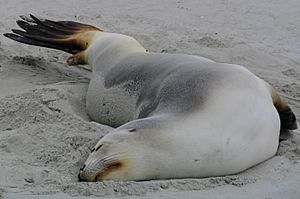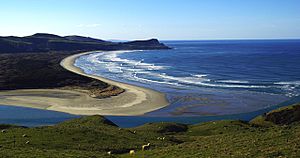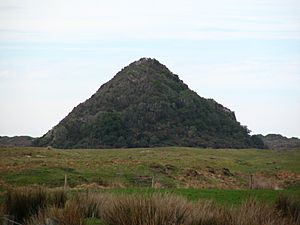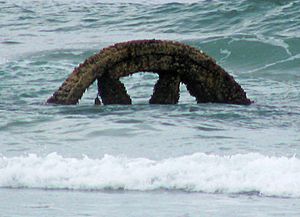Victory Beach facts for kids
Victory Beach is a beautiful sandy beach found on the Pacific Ocean coast of the Otago Peninsula in New Zealand's South Island. It's about 24 kilometers (15 miles) by road from Dunedin city and 7 kilometers (4.3 miles) from the town of Portobello. This is the longest beach on the peninsula, stretching for about 3.2 kilometers (2 miles). The beach got its name from a ship called the SS Victory, which sadly got stuck here in 1861.
Contents
Discovering Victory Beach's Geography
Victory Beach is about 3.2 kilometers (2 miles) long and faces mostly east. At its northern end, you'll find the tall cliffs of Kaika Hill, which reach out into the sea to form a headland called Te Wharekaiwi. To the south, the beach slowly turns into a muddy sandflat at the entrance of Papanui Inlet.
Behind the beach are tall sand dunes. These dunes protect a swampy area called Okia Flat. The beach and the headlands on either side form Wickliffe Bay. This bay is named after the ship John Wickliffe, which brought some of the first European settlers to Otago.
The Pyramids of Okia Flat
Okia Flat is home to two large rock formations made of basalt. These are known as the Pyramids. The larger one to the north is called the Large Pyramid or Pū-wheke-o-Kia. The smaller one to the south is the Little Pyramid or Te Matai o Kia. The Little Pyramid even has a cave near its bottom, which was carved out by ocean waves over many years.
How to Get to Victory Beach
To reach Victory Beach, you take Dick Road. This is a narrow, gravel road that starts where Weir Road and Papanui Inlet Road meet. The easiest way to get to these roads is from Portobello, a town on the Otago Harbour side of the Peninsula.
At the end of Dick Road, a 2-kilometer (1.2-mile) walking track leads you to the beach, passing by the Pyramids. You can take a short detour from the main track to climb up the Little Pyramid for a great view. After that, the track splits into a loop that takes you to the beach and a network of other paths over the dunes. Yellow and black poles mark the paths, but sometimes they can be a bit hard to spot.

Animals and Plants at Victory Beach
Victory Beach is a special place for many rare animals and plants. Part of the area is looked after by the Yellow-eyed Penguin Trust. You might be lucky enough to see yellow-eyed penguins here!
Amazing Wildlife
Other interesting birds you can find include royal spoonbills. The beach is also close to where royal albatross breed at Taiaroa Head. Both New Zealand sea lions and New Zealand fur seals also live in this area. If you look closely in the grass of Okia Flat, you might spot skinks and geckos. While they don't visit often, Okia Flat is known as the most likely place in Dunedin to see large elephant seals.
Unique Plants
The native pīkao grass that used to cover Okia Flat has mostly been replaced by marram grass and other plants brought in from other countries, like lupins. People are working hard to bring the pīkao grass back. There are also thick patches of tree nettle here, especially around the base of the Little Pyramid. It's important to avoid touching this plant as it can sting your skin.
Victory Beach's Past
Early Māori History
The cave at the bottom of the Little Pyramid is a very important archaeological site. Māori oral history tells us that a warrior once used this cave for shelter while he was recovering from injuries. Evidence shows that people lived here over 500 years ago. Scientists have found old tools, cooking remains, and bones from moa birds and humans.
The Shipwreck of the SS Victory
The steamship SS Victory left Port Chalmers on July 3, 1861, heading for Melbourne. It was carrying people, mail, and cargo. The ship ran aground (got stuck) at the southern end of Victory Beach around 6 pm. The captain tried to move the ship backward for about 90 minutes, but it was stuck deep in the sand. All the passengers and mail were safely taken off the ship, and no one was hurt.
Later, the ship's cargo, equipment, and even parts of its hull were sold off on the beach. They managed to get about £1,900, but the ship was originally worth around £25,000.
Victory Beach in Recent Times
Victory Beach was used as a filming location for a television movie called Out of Ashes.
|




